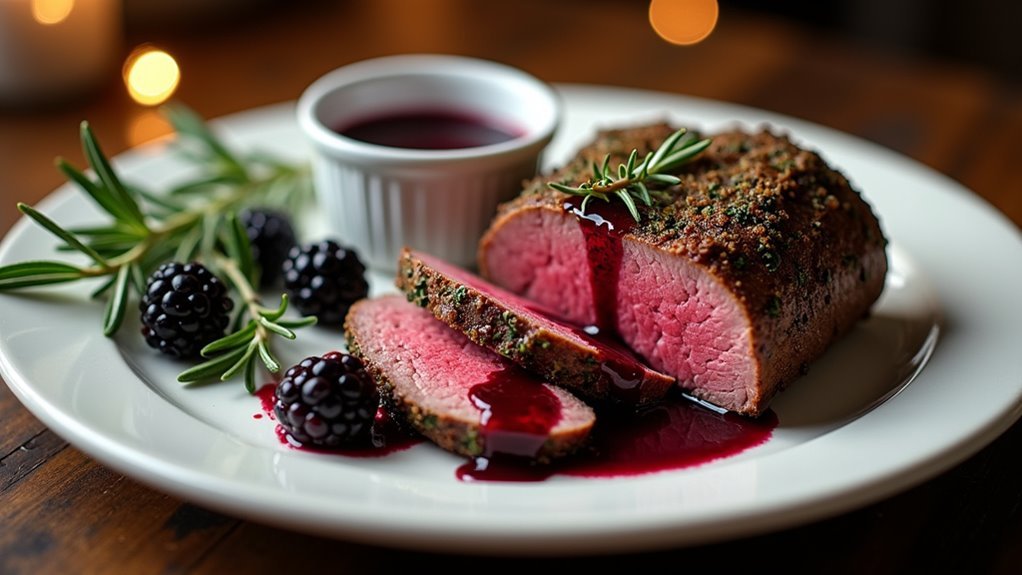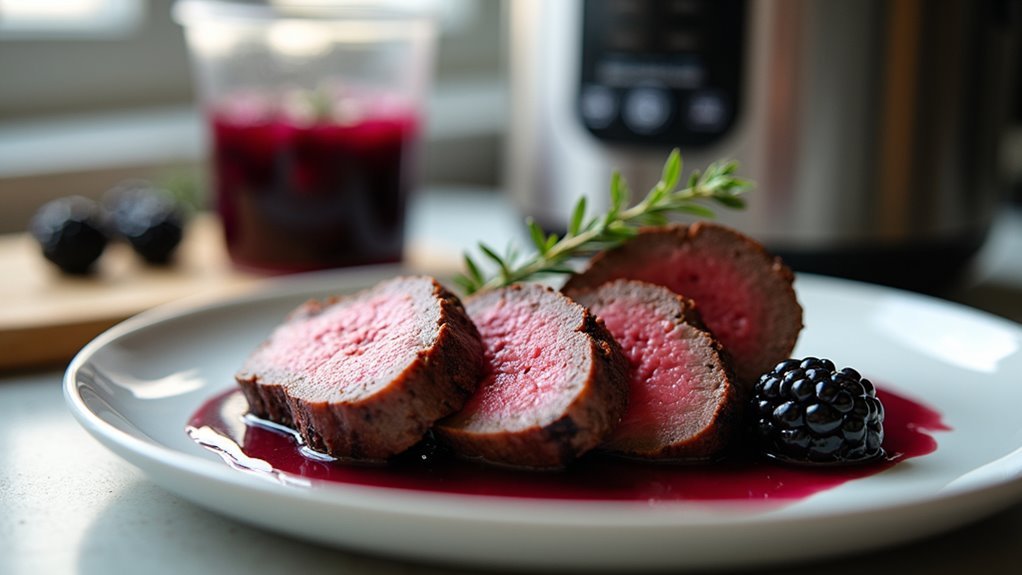You'll love this elegant beef tenderloin with blackberry sauce for your next special occasion. Start by sous vide cooking the trimmed tenderloin at 131°F for about two hours, then sear it briefly in a cast iron skillet. Meanwhile, craft a rich sauce by reducing blackberries with red wine, beef stock, and shallots. The tender beef pairs wonderfully with a bold Cabernet Sauvignon and sides like potato gratin. This foolproof method guarantees impressive results even if you're not an experienced cook.
Why Beef Tenderloin Makes the Perfect Special Occasion Dinner

Elegance personified, beef tenderloin stands as the ultimate centerpiece for your special occasion dinners.
A symphony of luxury on a plate, tenderloin transforms ordinary gatherings into memorable events.
Its reputation as the most tender cut of beef isn't just hype - it's culinary science. When you're hosting something truly important, perhaps an anniversary or holiday gathering, you want reliability with a touch of luxury.
What makes it perfect? I think it's the combination of impressive presentation and foolproof preparation.
Unlike other cuts that might dry out, tenderloin remains forgiving even for less experienced cooks. It's expensive, yes, but the "oohs" and "aahs" from your guests make every penny worthwhile.
Essential Equipment and Ingredients for Restaurant-Quality Results
To bring that special occasion tenderloin from merely good to truly remarkable, you'll need more than just the meat itself. The right equipment makes all the difference in achieving restaurant-worthy results.
First, invest in a reliable sous vide setup - perhaps an immersion circulator and vacuum sealer. I think a cast iron skillet is essential for that perfect sear after cooking.
Don't forget a good meat thermometer to verify temperatures.
For ingredients, quality matters. Select a center-cut tenderloin, sea salt, freshly ground pepper, and maybe some fresh herbs like thyme.
A bit of high smoke-point oil, such as grapeseed, will help with searing without burning. Additionally, proper equipment ensures food freshness, safety, and excellent cooking results.
Step-by-Step Preparation: From Trimming to Trussing
Before diving into the tenderloin preparation, you'll need to understand the importance of proper trimming and trussing. These steps aren't just formalities—they're essential for that perfect, restaurant-quality result.
First, tackle the silver skin. This tough connective tissue won't break down during cooking, so you'll want to carefully remove it with a sharp knife. Slide the blade just beneath it and gently pull while cutting.
Removing silver skin isn't optional—it's the difference between a tender roast and a chewy disappointment.
For trussing, grab some butcher's twine and tie the roast every two inches. This helps maintain that beautiful round shape we're after. Proper suction strength during vacuum sealing can also help preserve any leftover tenderloin, ensuring it stays fresh for future meals.
I think the trussing might seem intimidating at first, but trust me—it makes a world of difference in cooking uniformity.
Sous Vide Method: Achieving the Perfect Temperature

Sous vide cooking takes the guesswork out of achieving that perfect medium-rare center. I think it's honestly the most foolproof way to cook such an expensive cut.
For sous vide beef tenderloin success:
- Set your circulator to 131°F (55°C) for a perfect medium-rare
- Plan for about 2 hours of cook time, perhaps a bit longer for thicker cuts
- Pat the meat completely dry before searing
- Season generously right before the final sear
- Use extremely high heat for a quick 1-2 minute sear per side.
Additionally, the sous vide method ensures even heat distribution, which helps to achieve optimal results.
Crafting the Blackberry Sauce: Sweet and Savory Perfection
While your perfectly cooked tenderloin rests, it's time to focus on what I consider the crowning glory of this dish - a sophisticated blackberry sauce that balances sweet and savory notes perfectly.
The magic happens when fresh blackberries meet a reduction of red wine, beef stock, and a touch of butter.
Start by sautéing shallots until translucent, then deglaze with a good cabernet. I think the quality of wine matters here.
Add your berries, let them break down slightly, then strain if you prefer a smoother consistency.
Finish with a pat of cold butter for that restaurant-quality silkiness.
Serving Suggestions and Wine Pairings
The perfectly cooked beef tenderloin deserves thoughtful accompaniments that complement rather than compete with its natural flavors. I think selecting side dishes that provide textural contrast is key - perhaps a creamy potato gratin or roasted vegetables with a slight crunch. Additionally, incorporating vacuum sealing can extend the shelf life of your prepped side dishes, ensuring they remain fresh and flavorful until mealtime. For wine pairings, you'll want something that can stand up to the richness of the meat while complementing the blackberry sauce.
Let premium beef shine with sides that enhance rather than overshadow its elegant simplicity.
- Cabernet Sauvignon - classic pairing with robust tannins
- Malbec - fruit-forward notes that echo the blackberry
- Syrah/Shiraz - offers peppery notes that enhance the beef
- Aged Bordeaux - complex flavors for special occasions
- Zinfandel - if you prefer something slightly sweeter
Frequently Asked Questions
Can I Prepare the Tenderloin a Day Ahead?
Yes, you can prepare your tenderloin a day ahead. After cooking it sous vide, cool it quickly in an ice bath, refrigerate it sealed, then reheat and sear it before serving.
How Do I Store and Reheat Leftover Beef Tenderloin?
Store leftover beef tenderloin in an airtight container in your refrigerator for up to 3 days. Reheat it gently in a 275°F oven until warm or slice it thin for cold sandwiches.
What Can I Substitute for Blackberries in the Sauce?
Sweet as summer dreams, you can substitute raspberries, blueberries, cherries, or cranberries for blackberries. Strawberries work too, but you'll need to adjust sugar levels for each fruit's natural sweetness.
Is Sous Vide Necessary or Can I Use Conventional Oven Methods?
You don't need sous vide for tenderloin. You can absolutely use an oven method—just roast at 425°F until it reaches your desired internal temperature using a meat thermometer.
How Do I Adjust Cooking Times for Different Tenderloin Weights?
For each additional inch of thickness, add an extra hour to your sous vide cook time. You'll need 2 hours for standard cuts, regardless of weight if thickness remains the same.
